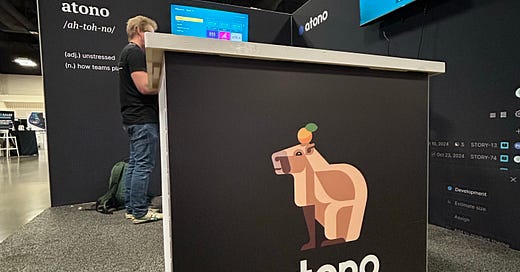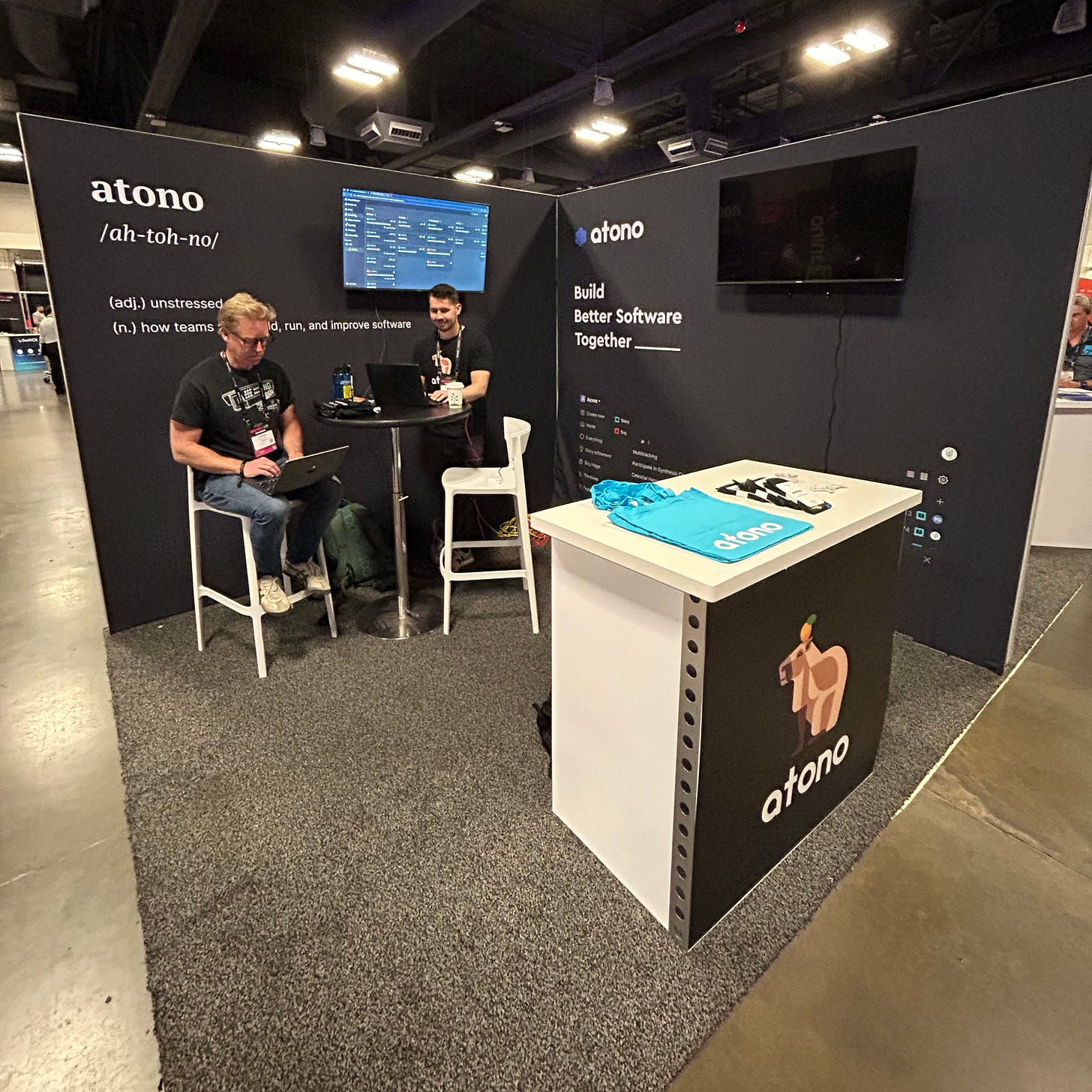What 170+ booth conversations revealed about developer tool fatigue
SaaStock attendees kept describing the same frustration. Here's what we learnt about context switching.
We thought we knew what to expect at SaaStock USA.
We'd done our homework. Prepared our demos. Practiced our pitch. We figured we'd get some good conversations, maybe a few leads, and learn what resonated with our target audience.
This was our first non-developer focused conference. Previous events like DevOpsDay, QCon, and DeveloperWeek skewed heavily technical, but SaaStock brought more founders and executives—teams that fit squarely in our target market.
We weren't prepared for the same conversation to happen 50+ times.
After 170 booth visits and demos with founders, CTOs, and senior developers, one thing became impossible to ignore: teams aren't struggling with individual tools. They're exhausted by the mental overhead of juggling disconnected systems.
What we discovered wasn't about our features—it was about something deeper. Teams aren't looking for better tools. They're looking for fewer handoffs.
The theme that kept coming up
The toggle tax is real.
The productivity loss from constantly switching between tools. The mental overhead of reconstructing context every time you jump from one system to another.
Here's the scenario we heard described over and over:
Check story in Tool A. Switch to Tool B for feature flags. Jump to Tool C to report bugs. Head to Slack for discussion. Repeat.
Each switch costs you. Not just time—focus.
"It's such a relief not having to juggle five different tools," one developer told us after our demo. "No silos, no handoff gaps. It's all just... connected."
That's when it clicked. The frustration isn't with individual tool quality. It's with the friction between tools that don't talk to each other.
This wasn't just feedback about our product—it was a revelation about the entire market.
What we learned from 50+ demos
The reactions we got taught us as much about the problem space as they did about our solution.
Story-embedded feature flags generated strong interest, especially from developers. "Wait, feature flags are actually embedded right into the stories? I've never seen that before in any tool, that's super unique."
Our Chrome extension sparked good conversations, especially about the ability to automatically collect essential context like the URL, browser information, and console and network errors. A few people asked whether end users could also report bugs this way—something we hadn't really considered before.
Here's what caught us off guard: completely different features resonated with non-technical founders. They gravitated toward visual planning—timelines, projected completion dates, consolidated team views.
We learned to adjust our demo strategy on the fly. Technical teams wanted to see integration points and workflow efficiency. Founders wanted visibility and delivery predictability. It made us realize how the same underlying problem—coordination complexity—manifests differently depending on your role.
The reactions weren't about the features themselves—they were about seeing integration done right. People weren't impressed by feature flags or integrated bug reporting individually. They were impressed by not having to switch contexts.
Why different approaches exist
The conversations helped us understand why the toggle tax exists.
Several attendees mentioned Linear and Jira during our conversations—tools that clearly work well for many teams. Linear is sleek and fast for issue tracking and product management, while Jira's power and customizability have made it an enterprise standard.
But we also heard frustrations. "The project view feels restrictive," one developer explained about Linear. "Like it's forcing me to work a specific way rather than fitting our workflow."
With Jira, the complexity was a common theme. "Jira's great because you can customize it a lot, but honestly, having to rely on so many plugins to get everything working makes it a beast to manage," another attendee told us.
Individual tools excel at their specific functions. Linear is fast for developers. Jira handles complex workflows. Traditional bug trackers manage ticket workflows.
The gap isn't missing capabilities—it's disconnected workflows. When feature flags live in one system, stories in another, and analytics in a third, teams lose context in the transitions. Atono stands out by combining feature flags, analytics, integrated bug triage, and cross-team visibility in one platform.
What surprised us most
Beyond the product discussions, we learned practical things we hadn't expected.
The demo swap approach was something new for us—visiting other booths for their demos, then inviting them to ours. It fostered longer lasting relationships post show compared to traditional booth interactions.
The post-show happy hour was a smart move—low cost, easy to pull off with the right partners. Partnering with well-known brands helped attract attendees, bringing in leads we might not have reached otherwise.
Our booth setup taught us lessons too. Popcorn and alcohol were a big hit, bringing people in and keeping them around. Having two people demo simultaneously let us handle multiple conversations without anyone waiting.
Swag worked best when it was small and easy to grab—no need for anything flashy or bulky. Not a surprise, but Capy definitely stood out and sparked good conversations. It was a solid icebreaker.
The pattern became impossible to ignore. Every positive reaction came down to the same thing: eliminating the friction between disconnected systems.
These conversations reminded us that building in isolation, even with great intentions, means missing perspectives we wouldn't discover otherwise.
What this means for your team
After 170 conversations, the market told us something we hadn't fully grasped.
The conference validated something we've believed since day one: tool fatigue isn't about having too many features. It's about losing context between tools.
Cross-functional teams don't just need shared access—they need shared context. They need to understand how work connects, why it matters, and what stage it's at across the entire development lifecycle.
Competitive advantage isn't about having the best individual features—it's about eliminating handoffs. The teams moving fastest aren't using more advanced tools. They're using more connected tools.
If your team is feeling the toggle tax—if you're losing productivity to context switching—it might be time to evaluate whether your current setup is helping or hindering your ability to build great software.
Ready to eliminate the toggle tax?
See how integrated workflows change everything.





